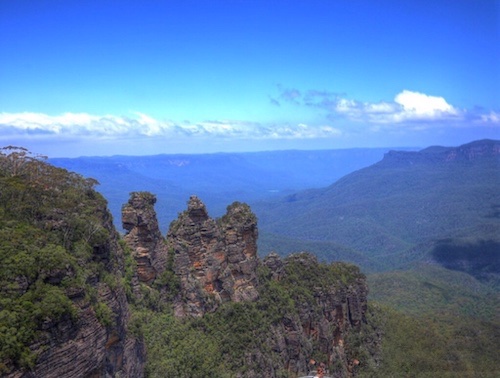
The Blue Mountains are a mountainous region in New South Wales, Australia. They border on Sydney’s metropolitan area, its foothills starting about 50 kilometres (31 miles) west of the state capital. The public’s understanding of the extent of the Blue Mountains is varied, as it forms only part of an extensive mountainous area associated with the Great Dividing Range. These are not mountains in the traditional sense so much as a giant plateau one to two thousand feet above sea level, dissected by deep canyons and gorges. It’s an area of breathtaking views and hidden natural wonders. A series of towns (including Leura and Katoomba) bisects the chain of National Parks extending for 240 kilometres from north to south and forming the Greater Blue Mountains World Heritage Area encompassing 1.03 million hectares. These National Parks include the Blue Mountains, Wollemi, Gardens of Stone and Kanangra-Boyd. A theme park, “Scenic World” lies in the center of the parks at Katoomba with two gondolas and a steep railway to get the best vistas of the scenery.




Australia’s main mountain range is the Great Dividing Range on the east coast. The eastern seaboard is where most Australians live, as this area gets substantial rainfall to support a large population. Most of Australia is actually desert or semi arid. The south of both Western and South Australia supports reasonably large populations. Both areas enjoy a mediterranean climate. The island state of Tasmania, just below the Australian continent is one of the most mountainous islands on Earth and has a temperate climate with regular rainfall. The Blue Mountains are named for the blue color the predominately Eucalyptus trees impart to the landscape in the elevated area around Sydney. We visited Scenic World as a part of our tour outside of Sydney.





The Three Sisters is the Blue Mountains’ most spectacular landmark. Located at Echo Point Katoomba, around 2.5 kilometres from the Great Western Highway, this iconic visitor attraction is experienced by millions of people each year. The Three Sisters is essentially an unusual rock formation representing three sisters who according to Koori (aboriginal legend) were turned to stone. The Koori (from Awabakal language gurri, as spoken in the area of what is today Newcastle, adopted by indigenous people of other areas) are the indigenous Australians that traditionally occupied modern-day New South Wales and Victoria. Really, these “mountains” are really plateaus, only about a thousand feet above sea level. While it is dry on top of the plateaus, the deep valleys hold rainforests. The lovely legend of the three sisters is as follows:



Once upon a time there was a powerful shaman (Tyawan) with three daughters Meenhi, Wimlah and Gunnedoo. Long ago there was a Bunyip who lived in a deep hole who was feared by all. Passing the hole was considered very dangerous, therefore whenever Tyawan had to pass the hole in search for food, he would leave his daughters safely on the cliff behind a rocky wall. One fateful day, Tyawan waved goodbye to his daughters and descended down the cliff steps into the valley. Meanwhile at the top of the cliff, Meenhi was frightened by a large centipede which suddenly appeared before her. Meenhi took a stone and threw it at the centipede. The stone continued on its journey and rolled over the cliff, crashing into the valley below which angered the Bunyip. The rocky wall behind Meenhi, Wimlah and Gunnedoo then began to split open and the three sisters were left stranded on a thin ledge at the top of the cliff. As the Bunyip began to approach the girls their father Tyawan used his magic bone to turn them into stone. Angered by this, the Bunyip then began to chase Tyawan. Becoming trapped, in order to flee from the Bunyip, Tyawan changed into a magnificent Lyre Bird, yet in the process dropped his magic bone. Tyawan and his three daughters were now safe from the Bunyip. Once the Bunyip had disappeared, Tyawan returned in search of his magic bone, yet this was never to be found. The Lyre Bird has been searching for this magic bone ever since. Remaining in rock formation, The Three Sisters stand silently overlooking the valley hoping that one day he’ll find the bone and turn them back to former selves.
[mappress mapid=”77″]
References:
Australia: http://www.fao.org/ag/agp/AGPC/doc/Counprof/Australia/australia.htm
Blue Mountains: http://www.bmbirding.com.au/
Scenic World: http://www.scenicworld.com.au/experience/scenic-railway/

